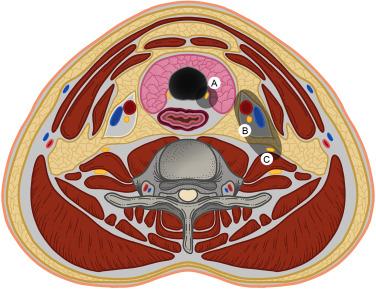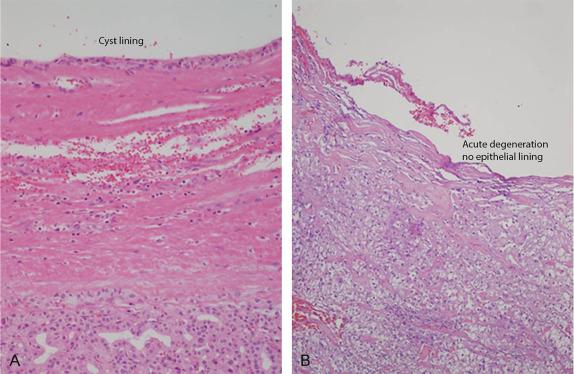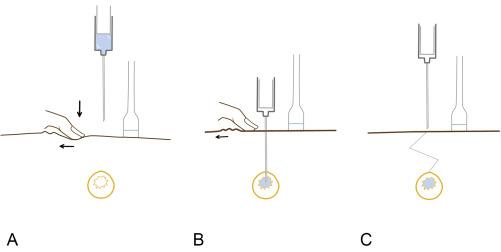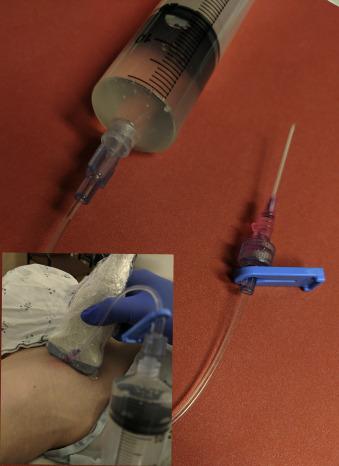Physical Address
304 North Cardinal St.
Dorchester Center, MA 02124
Floating Debris
Percutaneous Ethanol Injection: Cyst Injection
Percutaneous Ethanol Injection: Toxic Adenoma
Percutaneous Ethanol Injection: Metastasis
Ultrasound Cord Check
Thyroid neoplasms and cysts are common in the general population. The primary intervention offered to these patients in the United States is surgical removal. Despite the advances in surgical training and techniques, surgery carries a 2% to 10% risk of complications, even when performed in large-volume surgical centers. The wide availability of high-resolution ultrasound (US) equipment and the ever-increasing interventional expertise among practicing clinicians enables the use of novel US-guided percutaneous interventional procedures during office visits, in particular, percutaneous ethanol injection (PEI). The equipment costs and the needed materials are minimal for PEI compared with radiofrequency ablation (RFA) or LASER therapies. Although the use of percutaneous interventions has potential cost-saving benefits with fewer side effects, they are still not offered widely or as first-line therapies, particularly in the U.S. The head and neck lesions amenable to PEI, the techniques involved, and its efficacy, will be reviewed in this chapter.
Injection of chemical agents with nonspecific tissue destructive properties poses risks to patients; therefore acquiring expertise and training a team of skilled assisting staff are prerequisites. A thorough understanding of the US anatomy and recognizing the danger areas are needed to avoid procedure-related complications. A thorough explanation of the procedure, purpose, alternatives, and the risks involved with PEI should be disclosed to patients. Nervous patients who cannot be reassured verbally may require pretreatment with a suitable anxiolytic. Intravenous or conscious sedation is generally not needed for PEI. If desired, lidocaine infiltration is an acceptable form of anesthesia for PEI. During PEI, if a patient encounters unusual pain, voice changes (recurrent laryngeal nerve [RLN] or vagus nerve injury), or breathing difficulties, the procedure should be stopped immediately.
Several organic and inorganic chemicals have been tried as sclerosants in clinical practice for inducing tissue destruction and fibrosis. The agents that have been used for sclerotherapy are ethyl alcohol, talc, tetracycline and bleomycin, acetic and hydrochloric acids, and attenuated strains of bacteria. Even though various agents have been tried for the injection of thyroid cysts and tumors, the use of ethanol has become the mainstay for percutaneous injection sclerotherapy. In higher concentrations (> 95%), ethyl alcohol is very effective at inducing tissue destruction and sclerosis. Ethanol is not tissue specific in its destructive potential; therefore, whenever possible, only the minimal amount of alcohol required for therapeutic success is administered, using the thinnest gauge needle for any given tumor. This may even mean that submaximal treatment is administered over many sittings with reassessment and reinjections based upon response. A large-volume ethanol injection in any one sitting is best avoided because the diffusion of alcohol is unpredictable as the injected volume increases. Ethanol in high concentration destroys any type of tissue given sufficient duration of contact. Therefore a clear understanding of the anatomy and accurate needle placement under imaging guidance is crucial for preventing collateral tissue destruction during PEI. Ethanol-mediated tissue destruction is attributed to several mechanisms. Immediate functional impairment results from acute tissue dehydration and protein denaturation. The main effect is due to acute arteriolar and small vessel coagulation leading to gradual necrosis and fibrosis. Alcohol injection into recurrent cystic lesions results in the destruction of the epithelial lining and promotes inflammatory obliteration of the cavity leading to elimination of the dead space. Other agents such as hydrochloric acid, bleomycin, tetracycline, and talc are not typically used in the ablation of cysts or solid tumors of the neck in the adult population. The blood level of alcohol elevates transiently and drops within 1 hour after the procedure. Signs and symptoms of alcohol toxicity are encountered if the injected volume approaches or exceeds 100 mL. The volume typically required for PEI of head and neck tumors is much lower than this limit; therefore alcohol toxicity is not seen during PEI of thyroid cysts or nodules.
Understanding the US imaging-specific human anatomy of the neck is sine quo non for effective and safe PEI. Detailed discussion of US findings is discussed in chapters elsewhere in this textbook (see Chapter 13 , Ultrasound of the Thyroid and Parathyroid Glands). The most relevant anatomic correlation for PEI is described here. The thyroid gland is located anterior to the larynx and posterior to the strap muscles, with a ground glass echo appearance and flanked bilaterally by the great vessels. The location of the RLN, vagus nerve, and the great vessels are as depicted in Figure 51.1 , A. The cervical portion of the vagus nerve is typically located within the carotid sheath, posterolateral to the common carotid artery (CCA) in 80% of the subjects (see Figure 51.1 ). Less commonly it can be located anterolateral to the CCA. It can be seen during neck ultrasonography as a hypoechoic 2 to 3 mm thick, linear, avascular structure with echogenic striation. The location can be altered by the presence of metastatic lymphadenopathy or a large, laterally protruding nodular goiter. The right and left RLN nerves arise from the respective vagus counterparts in the lower part of the neck and course within the tracheo-esophageal (TE) grooves to supply the muscles of the larynx. (see Figure 51.1 ). The RLN cannot be reliably visualized with present-day US equipment. Alcohol injections performed on thyroid nodules or cysts located within the posteromedial aspect of the thyroid lobes, medially located central compartment thyroid cancer recurrences, and parathyroid adenomas carry risk of injury to RLNs. Attempted PEI of metastatic lateral compartment lymphadenopathy poses risks to vagus nerves, sympathetic ganglia, and accidental intravascular injection-related complications.

The following are the list of conditions most commonly subjected to outpatient PEI:
Cystic thyroid nodules and thyroglossal cysts
Toxic thyroid adenomas and nonfunctional benign thyroid nodules
Malignant metastatic thyroid cancer lymph nodes
Parathyroid adenomas and parathyroid hyperplasia
About 15% to 25% of thyroid nodules are cystic or predominantly cystic. Most thyroid cysts in adults are a sequelae of acute and spontaneous degeneration of solid nodules or gradual development of colloid cysts. The cyst cavities formed after acute cystic generation are often unlined with epithelium; therefore they are pseudocysts that perhaps acquire an epithelial lining ( Figure 51.2 ). Large simple colloid cysts can arise in the thyroid and are likely lined with epithelium. If cysts are lined with an epithelial layer, it may increase the risk for recurrence after aspiration and PEI, but this has not been systematically studied with histologic correlation. Most thyroid cysts are benign, and the risk of malignancy is about 6%. Therefore all cysts should be aspirated first and the cyst contents submitted for cytologic assessment to rule out malignancy before PEI. If a mural mass is encountered in a complex, even though it may be a predominantly cystic nodule, fine-needle aspiration (FNA) should be conducted based upon the individual US findings and malignancy should be ruled out before PEI. This also applies to thyroglossal cysts in adults.

If anesthesia is desired, US-guided infiltration with lidocaine up to the thyroid capsule using 27- to 30 G-needles is all that is required. Some interventionists do not use or recommend any form of anesthesia. If anything at all, local anesthesia helps calm the patient who anticipates pain with the procedure. There are considerable variations with pain perception and procedural tolerance among patients, which should be taken into consideration. After establishing infiltration anesthesia and observing aseptic precautions, a suitable size needle is inserted under US guidance to form a “Z-track.” The Z-track technique is a widely accepted practice that reduces leakage of administered medications after intramuscular (IM) injections. In the authors’ observation, this is an excellent technique that can be adopted for PEI to prevent alcohol leakage and reduce pain. The skin and the underlying soft tissue are gently but deliberately pulled away from the proposed site of needle entry before insertion of the needle. This leads to the formation of a “Z” track, and a built in “seal” develops upon withdrawal of the needle after completion of the injection ( Figure 51.3 ).

The selection of a suitable size needle makes the procedure brief and reduces pain. This, however, involves calculated guesswork and even trial and error and is influenced by the variable viscosity of the cyst contents. (see Video 51.1). The visualization of a flat or shifting fluid level within a cyst implies acute or subacute bleeding and separation of blood components. At least a portion of the cyst contents should be aspirated. Uniformly anechoic cysts can contain fluid consistency ranging from watery, thin colloid to the thickness of pine tar. The presence of fixed and immobile reverberation artifacts indicates highly viscous cyst contents. Cysts can also contain loose debris or mural masses that can clog the needle tip during aspiration. These can be dislodged under guidance by injecting a small amount of sterile saline or by the repositioning of the needle with gentle plunging of the piston or partial withdrawal followed by aspiration. When performing these maneuvers, it is important to stabilize the hub of the needle to make sure that the needle does not come out of the cyst. Reinsertion of the needle into a collapsed cyst cavity may not always be successful, particularly if the cyst cavity is mostly or completely empty. Attaching extension tubing between the syringe and needle is used to stabilize the needle tip from dislodgment from the cyst cavity during aspiration ( Figure 51.4 ). Modified percutaneous transhepatic cholangiography needles with side ports or “windows” have been shown to be effective in aspiration of cysts with viscid contents, but these needles are not available in the US. The goal is to use the smallest gauge needle for effective aspiration and injection. Access to a wide selection of needles of various gauges and lengths is desirable to handle the different situations that may be encountered. The amount of alcohol required for successful injection depends upon the completeness of aspiration, thin-floppy walls vs thick walled cyst, presence of mural mass, aspirated volume and the viscidity of cyst contents.

Zingrillo and others use a fixed volume of alcohol for injection, 2 mL of ethanol for cysts < 20 mL, 3 mL for 20 to 30 mL cysts, and 4 mL for larger cysts, and reported good outcomes. Shu et al. injected 50% of the aspirated cyst volume with ethanol but also removed the alcohol after a cyst wall contact time of 2 to 5 minutes; the needle was left in place for the entire duration of the procedure. The thinner the walls and more complete the cyst collapses after the aspiration, the lesser the volume of alcohol that needs to be injected. If there is doubt that the needle tip has penetrated the posterior capsule or accidentally withdrawn outside of the cyst, then it is advisable to not proceed with alcohol injection in that session. Reinsertion of the needle into a collapsed cyst is not always successful. If the needle is reinserted, the positioning of the needle tip within the cyst cavity should be confirmed by injecting a small amount of sterile saline under guidance, which can be reaspirated before completion of PEI. If the position of the needle tip cannot be confirmed with confidence, it is prudent to reassess the cyst a few weeks or months later when the procedure can be repeated as needed. Thyroglossal (TG) duct cyst aspiration and injection is similar to the one we have described. The limiting factor of PEI in TG duct cysts is the presence of very thick fluid that can thwart complete aspiration. PEI of a thyroid cyst is demonstrated in .
Become a Clinical Tree membership for Full access and enjoy Unlimited articles
If you are a member. Log in here